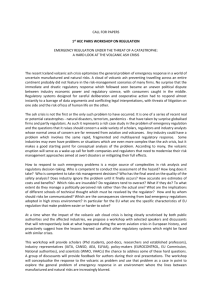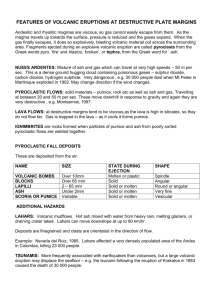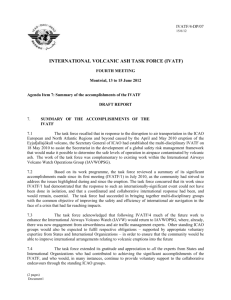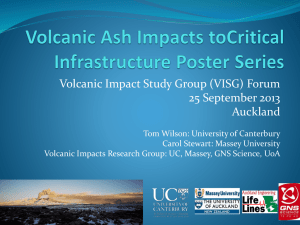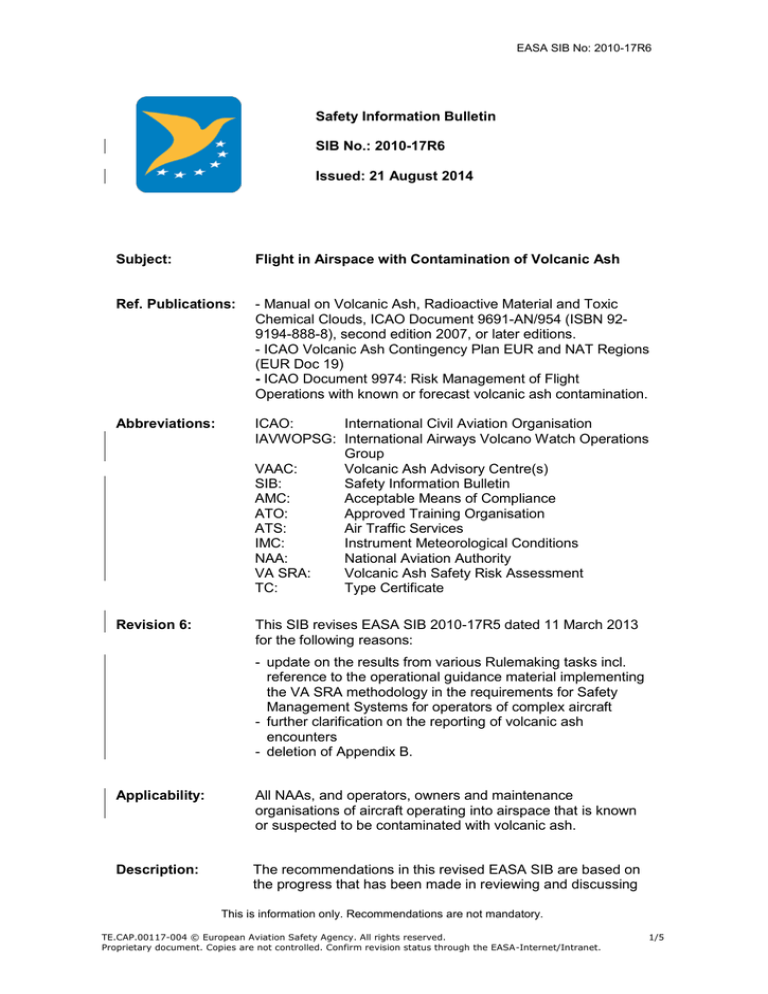
EASA SIB No: 2010-17R6
Safety Information Bulletin
SIB No.: 2010-17R6
Issued: 21 August 2014
Subject:
Flight in Airspace with Contamination of Volcanic Ash
Ref. Publications:
- Manual on Volcanic Ash, Radioactive Material and Toxic
Chemical Clouds, ICAO Document 9691-AN/954 (ISBN 929194-888-8), second edition 2007, or later editions.
- ICAO Volcanic Ash Contingency Plan EUR and NAT Regions
(EUR Doc 19)
- ICAO Document 9974: Risk Management of Flight
Operations with known or forecast volcanic ash contamination.
Abbreviations:
ICAO:
International Civil Aviation Organisation
IAVWOPSG: International Airways Volcano Watch Operations
Group
VAAC:
Volcanic Ash Advisory Centre(s)
SIB:
Safety Information Bulletin
AMC:
Acceptable Means of Compliance
ATO:
Approved Training Organisation
ATS:
Air Traffic Services
IMC:
Instrument Meteorological Conditions
NAA:
National Aviation Authority
VA SRA:
Volcanic Ash Safety Risk Assessment
TC:
Type Certificate
Revision 6:
This SIB revises EASA SIB 2010-17R5 dated 11 March 2013
for the following reasons:
- update on the results from various Rulemaking tasks incl.
reference to the operational guidance material implementing
the VA SRA methodology in the requirements for Safety
Management Systems for operators of complex aircraft
- further clarification on the reporting of volcanic ash
encounters
- deletion of Appendix B.
Applicability:
All NAAs, and operators, owners and maintenance
organisations of aircraft operating into airspace that is known
or suspected to be contaminated with volcanic ash.
Description:
The recommendations in this revised EASA SIB are based on
the progress that has been made in reviewing and discussing
This is information only. Recommendations are not mandatory.
TE.CAP.00117-004 © European Aviation Safety Agency. All rights reserved.
Proprietary document. Copies are not controlled. Confirm revision status through the EASA-Internet/Intranet.
1/5
EASA SIB No: 2010-17R6
the volcanic ash airspace contamination threat with the
associations from the manufacturing industry, operators, the
scientific community, the VAAC, the Air Traffic Management
Service Providers and Aviation Authorities in the ICAO
IAVWOPSG.
ED Decisions 2013/009/R and 2013/008/R (dated 16/04/2013)
amending AMC/GM to EU Regulation 965/2012, introduced
GM3 ORO.GEN.200(a)(3) for aircraft operators and GM3
ORA.GEN.200(a)(3) for ATOs, implementing the VA SRA
methodology in the requirements for Safety Management
Systems for operators of complex aircraft. This guidance
material is a direct transposition of the methodology provided in
ICAO Document 9974 “Risk Management of Flight Operations
with known or forecast volcanic ash contamination”;
- CS-25 Amendment 13 (dated 17/06/2013) introduced (for
new TC) § CS 25.1593 and related AMC on exposure to
volcanic ash hazards.
This SIB will be revised, following the completion of the open
EASA rulemaking tasks.
Recommendations: EASA makes the following recommendations:
(1) Avoid operation in visible volcanic ash or, where visibility of
the ash is impaired (IMC, night), avoid operation in
discernible volcanic ash.
(2) Forecasted presence of volcanic ash should primarily be
presented in the form of a zoning system that depicts
areas of low, medium and high concentrations in 3 altitude
bands.
EASA continues to recommend that ash concentration
charts provided by the London VAAC and Toulouse VAAC
should, for operations in European airspace, identify the
three zones as described in the ICAO Volcanic Ash
Contingency Plan EUR and NAT Regions (EUR Doc 019),
being:
- Area of Low Contamination (to be displayed in Cyan): an
airspace of defined dimensions where volcanic ash may be
encountered at concentrations greater than 0,2 x 10E-03
grams/m3, but less than or equal to 2 x 10 E-03 grams/m3.
- Area of Medium Contamination (to be displayed in Grey):
an airspace of defined dimensions where volcanic ash may
be encountered at concentrations greater than 2 x 10 E-03
grams/m3, but less than 4 x 10 E-03 grams/m3.
- Area of High Contamination (to be displayed in Red): an
airspace of defined dimensions where volcanic ash may be
encountered at concentrations equal to or greater than 4 x
10 E-03 grams/m3, where no ash concentration guidance
is available.
(3) When ash is forecast to be present within European
airspace, it is recommended that an operator conduct flight
This is information only. Recommendations are not mandatory.
TE.CAP.00117-004 © European Aviation Safety Agency. All rights reserved.
Proprietary document. Copies are not controlled. Confirm revision status through the EASA-Internet/Intranet.
2/5
EASA SIB No: 2010-17R6
operations in areas with Medium or High Forecast Ash
Contamination, only if they have established a safety risk
assessment for such operations.
(i)
For European operators, a Safety Risk Assessment
should be developed, and agreed with the respective
NAA, in accordance with the guidance provided in
GM3 ORO.GEN.200(a)(3) for aircraft operators or
GM3 ORA.GEN.200(a)(3) for ATOs.
(ii) Non-European operators should establish their
Volcanic Ash Safety Risk Assessment in accordance
with ICAO Document 9974: ‘Risk management of flight
Operations with known or forecast volcanic ash
contamination’.
(iii) EASA will collect information received from NAAs
(volcano@easa.europa.eu) to compile a list of
operators known to have developed an acceptable
Volcanic Ash Safety Risk Assessment.
EASA will keep a database of VA SRA as a living
document, to assist and facilitate in time of eruptions
and volcanic ash exercises.
(iv) It is recommended that Member States will not
normally close airspace that is forecast to contain ash
contamination, except for conditions under (v), in order
to allow the safety assurance process vested in the
VA SRA approach to have effect. Airspace closure
should be an action of last resort contemplated only in
situations in which the VA SRA approach can no
longer be relied upon to secure safe operations.
(v) Member States may decide to close airspace in the
immediate vicinity of a volcano where volcanic ashes
and gasses form a direct threat for the safety of flight.
(4) DELETED.
(5) In close vicinity to volcanoes that are observed on a 24
hour, 7 days a week basis, and where such equipment is
present to accurately observe the movement of the plume
and volcanic ash, local airport and air traffic management
procedures may exist to guide the aircraft outside airspace
where volcanic ash is present. The short range continuous
observation of the volcanic ash may produce an equivalent
result as the ash dispersion modelling and concentrations
charts that are in principle for the longer distances from the
volcano. Such local procedures should be acceptable to
the Competent Authority.
(6) When the aircraft and engine TC-Holders have not
developed instructions for continued airworthiness for
operation in airspace with a low contamination of volcanic
ash, EASA recommends the inspections to be performed
as listed in Appendix A, attached to this SIB.
(7) In case of encounter with volcanic ash in flight, flight crew
should immediately report it to the ATS Unit providing
This is information only. Recommendations are not mandatory.
TE.CAP.00117-004 © European Aviation Safety Agency. All rights reserved.
Proprietary document. Copies are not controlled. Confirm revision status through the EASA-Internet/Intranet.
3/5
EASA SIB No: 2010-17R6
service in that airspace. This real-time information will
facilitate providing operational feedback to the VAAC(s).
In addition to the established reporting lines, notably to the
engine and aircraft TC holders, the State of Registry of the
aircraft and to the NAA of the State(s) through which the
flight was conducted, operators should report to EASA
(report@easa.europa.eu) any encounter with volcanic ash
or any other relevant maintenance and airworthiness
related findings.
Such information will enable EASA to respond adequately
to possible airworthiness or maintenance issues, or to
update the recommended procedures in this SIB.
In the absence of any specific form for reporting volcanic
ash encounters, operators may use the form attached to
the record of this SIB on the Agency website.
EASA requests the feedback from EU Member States and
associated countries, the airspace management organisations
and operators for improvement of this SIB, and to be informed
of any difficulties that are being experienced on implementing
the safety recommendations contained in this SIB. The SIB will
be revised as necessary.
Contacts:
For further information contact the Safety Information Section,
Executive Directorate, EASA; E-mail: ADs@easa.europa.eu.
Any comments or queries can be submitted to EASA by E-mail
to: volcano@easa.europa.eu.
To obtain a copy of ICAO Documents, contact the ICAO
Customer Services Unit,
telephone +1 514-954-8022, facsimile +1 514-954-6769,
or by e-mail request to sales@icao.int.
Websites:
Additional information on the subject addressed by this SIB can
be found on the following websites:
www.icao.int
www.easa.europa.eu
This is information only. Recommendations are not mandatory.
TE.CAP.00117-004 © European Aviation Safety Agency. All rights reserved.
Proprietary document. Copies are not controlled. Confirm revision status through the EASA-Internet/Intranet.
4/5
EASA SIB No: 2010-17R6
Appendix A – General advice for aircraft (all turbine and piston powered aircraft,
including rotorcraft) maintenance inspections when operating in airspace with a
low contamination of volcanic ash
(1) The following is provided as advice to operators if their aircraft and/or engine TC
Holders have not developed instructions for continued airworthiness for
operation in airspace with a low contamination of volcanic ash.
(a) Accomplish daily inspections when operating in an area of low volcanic ash
airspace contamination, to detect any erosion, accumulation of volcanic ash,
or any aircraft- and/or engine damage or system degradation. Turbine
engines as well as piston engines operation can be adversely affected by
volcanic ash on the ground or in the air.
The inspections should include the following:
-
wing leading edges
navigation and landing lights, radomes
landing gear
horizontal stabiliser
all extruding structure
pitot tubes and static ports
windows and windshields
engine inlets and nacelles (turbine), induction air filter (piston)
engine cooling system components
engine compressor and turbines
engine oil systems
fuel tank venting system
rotor blades
ventilation and pressurization systems (e.g., the air cycle machines, ozone
converter, recirculation fans, HEPA filters, etc.)
- smoke detectors (e.g., detectors located in the cargo compartment, lavatory,
electrical equipment bay, remote crew rest areas, etc.)
Based on the findings of the above inspections, more detailed inspections (such
as boroscope inspections of the engine, oil analysis, inspection of filters,
cleaning of parts) may be necessary.
Unless specific instructions have already been provided by aircraft and engine
TC holders to be applied after encountering a volcanic ash, the above
inspections should also be performed after each flight, whenever the following
phenomena are observed or detected or experienced during flight.
-
Acrid odours similar to electrical smoke
Rapid onset of engine problems
St. Elmo’s fire
Bright white/orange glow appearing at the engine inlets
Dust in the cockpit or cabin
Sudden (unexpected) outside darkness
Airspeed fluctuations
Landings lights casting sharp, distinctly visible beam
(b) Protect and cover aircraft that are parked in areas that may be contaminated
by the fall out or settling of volcanic ash in accordance with the aircraft- and
engine TC-holder’s advice where possible. Any volcanic ash residues must
be removed prior to operations and following the TC Holder’s
recommendations when available.
This is information only. Recommendations are not mandatory.
TE.CAP.00117-004 © European Aviation Safety Agency. All rights reserved.
Proprietary document. Copies are not controlled. Confirm revision status through the EASA-Internet/Intranet.
5/5

